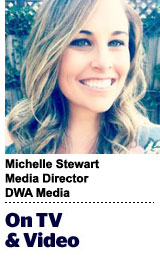 “On TV And Video” is a column exploring opportunities and challenges in advanced TV and video.
“On TV And Video” is a column exploring opportunities and challenges in advanced TV and video.
Today’s column is written by Michelle Stewart, Media Director at DWA Media. Michelle will present “Defining KPIs For B2B Marketers” at AdExchanger’s upcoming PROGRAMMATIC I/O New York conference on October 25-26.
The appeal is undeniable: “Programmatic” connotes digital trackability, and “TV” has an old-brand feel.
It’s no surprise that the channel intrigues B2B marketers, yet some misperceptions are keeping them on the sidelines. TV spots are incredibly effective for branding, and programmatic TV, which I define as data-driven TV buying, is truly the best of both worlds.
I think of programmatic TV as an umbrella term for advanced TV, which includes connected TV (on-demand or streaming) and addressable TV (data-driven linear). Regardless of the specific iteration of data-driven TV, B2B marketers should test its impact and efficiency before demand and, subsequently, costs increase for the channel.
Engage And Stand Out
As B2B marketers explore new avenues to reach their audiences, they are continually met with consumer-centric controls such as ad blocking. Marketers long for measurable media, but if consumers have the ability to block online ads, brands need another avenue that’s still measurable.
In many industries, such as the cybersecurity, storage and networking hardware spaces, B2B buyers tend to be familiar with only two or three market leaders. Programmatic TV allows B2B brands to be disruptors; it provides the impact of a big branding play with the specificity afforded by bidding technologies.
Because few B2B companies are testing programmatic TV, those who are have the advantage of making noise in an uncrowded arena. Being the only cloud conversation in the middle of a Coke ad and a Doritos ad isn’t the worst place to be.
Finding And Measuring A Finite Audience
B2B marketers want to be able to track media’s effectiveness and make the largest impact possible on the select few. More often than not, they have to make a business case to the C-suite to justify their marketing activity.
While the granularity of targeting isn’t as robust as it is for digital media, programmatic TV allows B2B brands to advertise to specific geographical locations, leverage third-party data segments and select programming and time of day for their spots. Marketers want to confirm that they’re only serving ads to key decision-makers, which is why account-based marketing (ABM) is so popular within the B2B sector – with ABM, marketers can influence the buying decisions within specific accounts. The nascent marriage of ABM and programmatic TV will prove fruitful for marketers with finite audiences.
Get Air Cover For Long Sales Cycles
B2B sales cycles are long, so initial engagement is rarely an actual purchase. It generally takes longer than 30 days for a company to decide which enterprise software or cloud solution they’ll implement. There are multiple touch points to consider, and marketers have to speak to both broad buying committees and the smaller committees they funnel into to influence the entire decision-making process.
I typically recommend constant air cover for several months for a B2B audience due to the long sales cycles.
TV is still a powerful medium to increase brand awareness, even if a viewer isn’t paying his or her full attention to an ad. More B2B companies should push that larger awareness angle.
Rethinking Perceptions
If programmatic TV is so great, why aren’t more B2B buyers adopting the channel?
For one, B2B companies tend to be slower adopters to new channels and mediums, creating challenges for marketers who wish to explore the opportunities afforded by programmatic TV. They usually need a case study before taking the first step into uncharted territory; there needs to be proof of success and how a new media tactic or channel works to receive executive buy-in. The larger the organization, the more marketers need that assist.
I recommend B2B marketers change the way they view programmatic TV. Ditch the perception that TV is costly. Think of programmatic TV from a digital angle: targetable, trackable and cost-efficient.
Follow DWA (@dwaTechMedia) and AdExchanger (@adexchanger) on Twitter.













